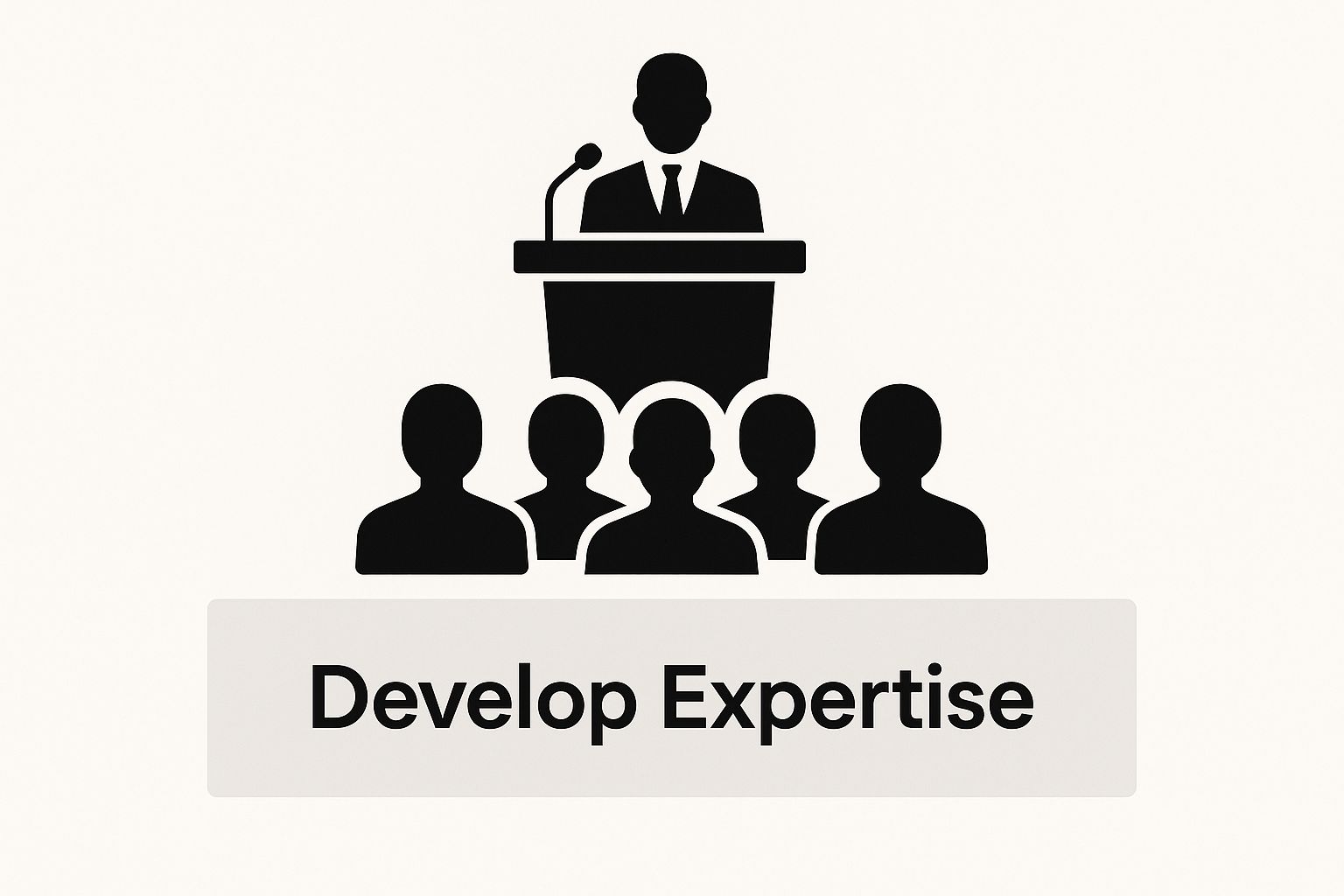
What Is Thought Leadership and How to Build It
Published on 2025-10-06
So, what does "thought leadership" actually mean?
It’s about more than just knowing your stuff. It's the act of becoming a trusted expert in your field by consistently sharing valuable, original insights. The real magic isn't just in what you know, but in how you share that knowledge to guide your audience and help them solve their biggest problems.
What Is Real Thought Leadership Anyway

Let's cut through the buzzwords. True thought leadership isn't about shouting the loudest on social media or echoing what everyone else is saying. It’s about becoming the most trusted and reliable guide in your corner of the world.
Think of it like this: you're trying to navigate a thick, unfamiliar forest. A real thought leader is the guide who doesn’t just give you a generic map. They're the one who points out the hidden trails, warns you about the dead ends, and spots opportunities others walk right past. They know the terrain because they’ve been through it.
Moving Beyond a Buzzword
The term gets thrown around a lot, but at its heart, thought leadership is all about action and impact. It’s a deliberate strategy focused on providing original, helpful insights that answer your audience's most difficult questions. This is what separates genuine experts from people just repeating old news.
When you do this consistently, you change how people see you. You're no longer just another person offering a service; you become an essential advisor. You're the first person people think of when they hit a roadblock.
True thought leadership transforms your reputation from transactional to foundational. You become part of your audience’s decision-making process before they even consider making a purchase.
The Core Components of Authority
Building this kind of authority isn't about knowing everything. It's about mastering a specific niche where your unique perspective is your biggest strength. Your personal experiences, your data-backed insights, and your predictions for the future are what set you apart.
It really boils down to three key things:
- Deep Expertise: A solid grasp of your subject, built from real-world experience and a commitment to always be learning.
- A Unique Perspective: The confidence to offer a fresh take or question old habits, giving people value they can't get anywhere else.
- Consistent Generosity: A genuine willingness to share what you know freely, without expecting anything in return right away.
Ultimately, figuring out what thought leadership is is just the start. The real journey is learning how to be a thought leader by putting these ideas into practice. That consistent effort is what builds a reputation that pulls in opportunities, clients, and partners—making it a powerful strategy for any professional's long-term growth.
Why Thought Leadership Actually Drives Business Growth
Becoming a go-to expert in your field isn't just a vanity project. It’s not about follower counts or ego. It directly translates into real, measurable business results. When you consistently share valuable insights, you change the entire conversation. You stop pitching products and start offering solutions.
This shift is what builds deep, authentic trust. It turns a hard sell into a helpful consultation with an advisor people genuinely want to listen to. That trust is the fuel for sustainable growth. Instead of chasing down leads, you start attracting them.
Potential clients show up already half-convinced of your expertise because they’ve been learning from your content. This drastically shortens the sales cycle. They aren't just buying a service; they're investing in your proven perspective and your ability to solve their problems.
Building Your Competitive Moat
Let's face it, most markets are flooded with similar-looking companies all competing on price. Thought leadership gives you a competitive advantage that’s almost impossible for others to copy. Your unique insights and the authority you build around them become your brand’s protective moat.
This positioning makes you the obvious choice for clients who value real expertise over a rock-bottom price.
People are drawn to experts who provide clarity and cut through the noise. By consistently sharing what you know, you become a beacon of stability for them. This doesn't just bring in new business; it also helps you attract top-tier talent who want to work for and learn from the best.
A strong thought leadership strategy takes the risk out of the buying decision for your clients. When they choose you, they feel like they’re making the smartest, safest bet.
Turning Insights into Influence
This isn't just a theory; the numbers back it up. Thought leadership has become a serious factor in how businesses make decisions. A recent study found that 99% of buyers believe a vendor's thought leadership is important or critical when they make a purchase.
The same research showed that 49% of buyers feel it helps them avoid making a bad choice, while 81% of decision-makers say it gets everyone on their team aligned, which speeds up the whole sales process. You can dig into the full 2025 Value of Thought Leadership report on MomentumABM to see all the data.
Ultimately, a smart thought leadership plan hits several key business goals at once:
- Generates High-Quality Inbound Leads: The right people find you because you've already provided them with value.
- Increases Customer Loyalty: Clients stick around because they trust your guidance and believe in your vision.
- Commands Premium Pricing: Your expertise justifies a higher price, pulling you out of the race to the bottom.
When you focus on what thought leadership really is—a genuine commitment to sharing what you know—you’re not just making content. You're building a powerful asset that will fuel profitable, long-term growth for your business.
The Three Pillars of a Strong Thought Leadership Strategy
Becoming a go-to expert in your field doesn't just happen. It's not a happy accident; it’s the result of a deliberate and thoughtful strategy. Building this kind of influence isn't just about posting content—it’s about carefully constructing a platform based on three critical pillars: Expertise, Originality, and Consistency.
Think of these as the three legs of a stool. If one is missing, the whole thing topples over. Expertise without a unique perspective is just noise. Originality without a consistent presence is a flash in the pan. And consistency without real expertise is just hollow repetition. You need all three working in harmony.
Pillar One: Develop Deep Expertise
Everything starts here. The bedrock of any real thought leadership is genuine expertise. This isn't about having a surface-level understanding of a topic. It's about knowing your specific niche inside and out, armed with the kind of practical wisdom that only comes from years of hands-on work, endless curiosity, and a commitment to always be learning.
Your expertise is what gives you the right to have an opinion. It’s the substance behind your statements, turning generic advice into a nuanced perspective that actually helps people solve tough problems. To make sure your expertise hits the mark, you first have to know who you're talking to. Using solid audience research methods is key to understanding their pain points and tailoring your insights to what they truly need.

As you can see, expertise isn’t something you just keep to yourself. It grows and gets stronger when you share it, engage in discussions, and actively help others.
Pillar Two: Cultivate Originality
In a sea of endless content, your unique perspective is what makes you visible. Originality doesn't mean you have to reinvent the wheel with every post. It's about your unique spin on things—how you connect dots that others miss, challenge old assumptions, or find a new story in the data.
It’s about graduating from repeating what everyone else is saying. Instead, you offer a fresh angle or a counterintuitive idea that makes people pause and reconsider.
Original thought leadership isn't about having all the new answers. It's about asking better questions and framing existing problems in a new light.
So, how do you find that original spark?
- Connect Disparate Ideas: Find surprising parallels between your industry and a completely different field.
- Challenge a "Best Practice": Take a hard look at a common industry belief. Is it still true? Argue for a better way.
- Share Personal Stories: Nothing is more original than your own experience. Frame your insights with stories of your wins and, even more powerfully, your failures.
This unique point of view is what earns you a dedicated following. People won't follow you for information they can find anywhere. They'll follow you for your take on it.
Pillar Three: Maintain Unwavering Consistency
The last piece of the puzzle is consistency. This is the pillar that transforms a single great idea into a lasting reputation. When your audience knows they can count on you for regular, high-value insights, you build immense trust and stay at the forefront of their minds.
But consistency is more than just a posting schedule. It’s about a unified message. Each piece of content you share should reinforce who you are and what you stand for. By showing up reliably, you demonstrate your commitment and solidify your status as the go-to person in your space. Over time, that's how true loyalty is built.
Your Blueprint for Building Authority on LinkedIn
Think of LinkedIn as the modern-day town square for professionals. It’s the place to build your reputation. But just showing up with a profile isn't enough to get noticed. To really build authority, you have to turn your page from a static resume into a lively hub for industry insights and real conversations.
This isn’t about just shouting your wins from the rooftops. It’s about strategically sharing what you know so people see you as the go-to person in your field. The goal is to build a presence that doesn't just collect followers, but earns genuine trust with the decision-makers who are looking for real expertise.
First, Make Your Profile Scream "Expert"
Before you even think about posting, your profile has to do the heavy lifting. It's the cover of your professional story—it needs to make people want to open the book. A few simple tweaks can completely change how people see you.
Start with your headline. Don't just list your job title. Turn it into a powerful value proposition. Instead of "Marketing Manager at Company X," try something like, "I Help B2B SaaS Companies Double Their Inbound Leads with Killer Content Strategy." See the difference? One says what you are, the other says what you do for people.
Next, rewrite your "About" section. It shouldn't read like a boring list of job duties. Tell your story. Share your professional philosophy and get straight to the point about the problems you solve. To really dial this in and stand out from the crowd, it's worth exploring different strategies to build a personal brand on LinkedIn.
Create Content That Actually Starts a Conversation
With your profile sharpened, it’s time to focus on your content. Your posts are the fuel for your thought leadership engine on LinkedIn. The best content is always the kind that gets people talking and gives them something they can actually use.
Try mixing in these high-impact formats:
- Real Stories, Real Lessons: Talk about a time you succeeded, failed, or learned something the hard way, and tie it back to a bigger industry truth. This makes your expertise feel human and relatable.
- Data-Backed Opinions: Find a surprising statistic and offer your unique take on it. Explain what it really means for your industry and don't be afraid to challenge the status quo.
- Simple "How-To" Guides: Break down something complicated into a few easy-to-follow steps. This immediately positions you as a generous expert who’s happy to help.
The trick is to stop posting generic updates and start sharing content that makes your audience pause and think. This is exactly what decision-makers are hungry for.
According to the 2024 Edelman-LinkedIn B2B Thought Leadership Impact Report, 54% of C-suite executives spend at least an hour every single week consuming thought leadership content.
This statistic tells a powerful story: the people at the top are actively looking for smart perspectives to guide their choices. Even more telling, over 75% of these leaders said this kind of content prompted them to research services from a company they hadn't considered before. That shows a direct line from thought leadership to new business.
It’s a Conversation, Not a Monologue
Finally, remember that thought leadership isn’t a one-way broadcast. You can't build authority by just talking at people. You have to be an active, engaged member of the community.
That means leaving meaningful comments on other people’s posts—comments that add real value to the discussion. It means answering questions in your own comment section and connecting with your peers without a hidden agenda. When you do this, you show you're not just an expert, but a collaborator people want to know. Our comprehensive guide digs deeper into how to become a thought leader on LinkedIn and beyond.
Learning from Real-World Thought Leaders

Theory is great, but seeing how the pros do it is where the real learning happens. To really get what thought leadership looks like in the wild, it helps to break down the strategies of people and companies who are absolutely crushing it. These aren't just content creators; they’re the ones steering the entire conversation in their fields.
When you look closely at what they're doing, you start to see how the key ingredients—expertise, originality, and consistency—all work together to build a powerful voice. Every successful thought leader has their own style, but they all share a relentless focus on delivering real value to their audience.
The B2B SaaS Niche Dominator
A perfect example is a B2B SaaS company that has completely dominated its niche by publishing deep, data-backed research. Instead of just writing blog posts about their product's features, they release annual industry reports packed with original stats and trends. This smart move shifts their identity from just another software vendor to the go-to source for market intelligence.
This strategy is brilliant because they create content that other professionals—journalists, analysts, and fellow creators—need and rely on. By doing the heavy lifting of research, they become essential to the ecosystem, earning them credibility and top-tier backlinks that are nearly impossible for competitors to match. It’s a masterclass in turning specialized knowledge into a serious competitive edge.
The Solo Consultant Turned Influencer
Another great model to follow is the solo consultant who builds an entire personal brand from scratch. Typically, they pick one platform, like LinkedIn, and commit to sharing daily insights from their client work, personal stories, and unique perspectives. Their content is a compelling blend of actionable advice, bold opinions, and even a bit of vulnerability.
The term thought leadership was first introduced back in 1994 by Joel Kurtzman, who was editor-in-chief of Strategy+Business magazine. Fast forward to today, and 76% of senior leaders say it helps them make smarter business decisions, proving its long-lasting influence. You can check out more stats on the impact of thought leadership at dsmn8.com.
This approach creates a powerful, personal bond with their audience. Followers start to feel like they genuinely know the expert, which builds incredible trust and loyalty. By consistently showing up with a clear point of view, these consultants attract a flow of perfect-fit clients who are already bought into their approach before they even hop on a call.
For more inspiration, it's worth exploring these thought leadership content examples from a wide range of industries.
Common Questions About Thought Leadership
So, you're thinking about stepping into a thought leadership role. It's a great move, but it often comes with a few big questions. Let's tackle some of the most common ones I hear from aspiring experts.
How Much Time Do I Need to Commit to Become a Thought Leader?
This is probably the number one question people ask, and the answer is simpler than you think: it’s more about consistency than sheer volume. Think of it like training for a marathon. You wouldn't just go out and run 26 miles once a month. You'd train steadily, week after week.
Building authority works the same way. A few focused hours every week will always beat a frantic, all-day sprint once in a blue moon.
Most professionals who succeed with this start by blocking off 3 to 5 hours a week. That’s enough time to think deeply, draft some content, and engage with your community without hitting burnout. As you get into a rhythm, you’ll naturally get faster at creating impactful content, and this steady presence is what builds your reputation as someone reliable and knowledgeable.
"Consistency is the secret ingredient for trust.” - Jane Doe, industry expert
To make this feel manageable, try breaking it down:
- Create: Block out two 90-minute sessions for research and writing.
- Refine: Spend 30 minutes after each session reviewing and editing your work.
- Engage: Set aside an hour a week just for connecting with others—commenting on posts and sharing what you’ve learned.
How Do I Find a Unique Angle in a Crowded Market?
It's easy to look at a crowded space and think, "What could I possibly add?" The key is to stop trying to invent something entirely new and instead focus on your unique perspective. Your best angle is found at the intersection of your personal story, your specific skills, and the problems your audience is actually facing.
Think of it like being an artist. The great painters didn't invent new colors; they just mixed the existing ones in ways nobody had before. Your voice is your unique mix. It might feel subtle at first, but combining familiar ideas in your own way is what makes people stop and listen.
Innovators don’t invent new paint. They remix hues no one expected.
Not sure where to start? Try these simple exercises to uncover your unique angle:
- Map out three things you’re genuinely good at, then list common problems people face in your industry. Where's the overlap?
- Ask a few peers about the most surprising lesson they’ve learned in their career. What themes pop up?
- Take a popular "best practice" in your field and respectfully challenge it. Is it still relevant? What are its flaws?
Keep a running list of these little insights. Your unique angle will emerge from there.
How Can I Measure the ROI of Thought Leadership?
Measuring the return on your time and effort isn't just about hard numbers. It's a mix of leading indicators (the early signs that things are working) and lagging metrics (the quantifiable results that follow).
Leading signs are the qualitative wins: people sending you unsolicited messages, invitations to speak on podcasts, or others sharing your content without you asking.
Lagging metrics are the ones you can track on a spreadsheet. Things like:
| Metric | Type | Example |
|---|---|---|
| Inbound Outreach | Leading | Unsolicited messages from prospects |
| Profile Views | Lagging | A 40% month-over-month increase |
| Shorter Sales Cycle | Lagging | Closing deals 10 days faster on average |
To make sense of it all, you need a simple process:
- Get a baseline. Before you post anything, write down your current metrics.
- Track weekly. Use LinkedIn analytics and your own profile data to see what’s changing week to week.
- Review monthly. Look at the month-over-month trends to see the bigger picture and decide where to focus next.
I worked with a consultant who did exactly this. After four months of consistent effort, she tracked a 60% increase in inbound leads and saw her direct requests for consultations double. By tracking both the qualitative feedback and the hard numbers, you get a complete picture of the impact you're making.
Tips to Keep the Momentum Going
The initial excitement is great, but how do you keep the engine running a few months down the line? It all comes down to clarity and celebration.
Keeping your momentum is about building a sustainable habit, not just a temporary campaign. Here are a few ways to stay on track:
- Review your progress. Take 15 minutes every Sunday to look at your simple metrics dashboard.
- Celebrate small wins. Did someone leave a really thoughtful comment? Did you get a mention in an industry newsletter? Acknowledge it!
- Mix it up. Tired of writing articles? Try a short video, a poll, or a visual carousel to keep things fresh for you and your audience.
- Team up. Partner with a peer for a co-authored post or an interview. It breaks up the routine and introduces you to a new audience.
This simple routine helps you avoid fatigue and ensures you're steadily building the authority you're aiming for.
Ready to elevate your LinkedIn presence? Try autoghostwriter today for scroll-stopping posts. Visit autoghostwriter.com now and boost engagement in minutes.